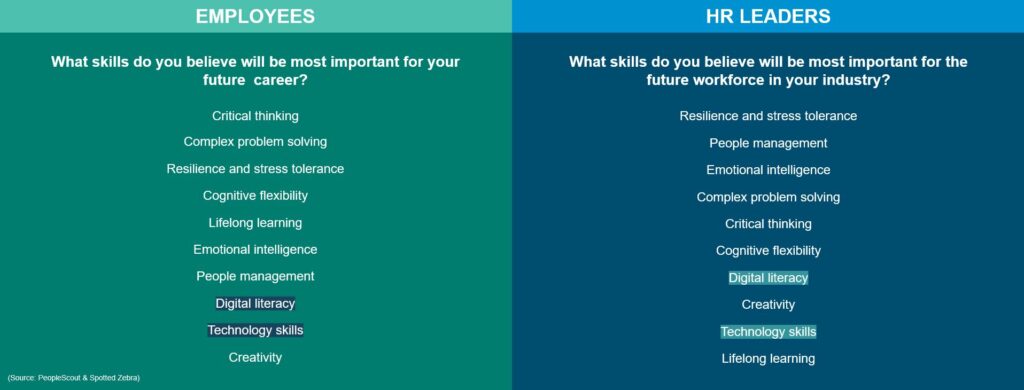With labour shortages and intensifying talent scarcity, hiring challenges are only increasing, impacting all industries. To tackle these hiring difficulties, many leaders look to external solutions like expanding their talent pool or enhancing their employer brand. However, one of the most effective and sustainable solutions is already inside your organisation. Developing existing employees through internal mobility is key to filling skills gaps now and in the future.
Keep reading to learn more about internal mobility, why internal mobility programs are crucial for future success and how you can leverage reskilling and upskilling programs to facilitate internal mobility at your organisation.
What is Internal Mobility?
The goal of internal mobility is to match your existing talent to open positions through internal transfers, job rotations, secondments and promotions. An internal mobility program is a structured process that facilitates the movement of employees, both vertically to higher or lower positions as well as laterally between roles at the same level. These programs are often anchored in reskilling and upskilling initiatives focused on developing employees’ skills and capabilities to meet evolving organisational needs.
Reskilling programs aim to provide training to help employees gain new skills that allow them to transition into different roles or business areas. For example, a finance employee can reskill to learn data analytics and move into a business intelligence role.
Upskilling programs focus on building additional skills and competencies related to an employee’s current role or expanding their knowledge in their field. For example, a marketing manager can upskill their digital marketing capabilities in social media and digital advertising platforms to take on a more strategic role in the department.
The Benefits of Internal Mobility
A strategic focus on internal mobility provides both talent management and bottom-line benefits for an organisation, including:
- Improved employee retention and engagement: Providing clear paths for career development and advancement within the company increases employee satisfaction and loyalty. Employees feel valued and motivated when they see opportunity for upward or lateral mobility.
- Stronger talent pipeline: An internal mobility program creates a robust pipeline of qualified candidates for open roles from within. According to research from LinkedIn, organisations that leverage skills-first hiring expand their talent pool by nearly 10x on average compared to those simply looking for similar job titles or industry experience.
- Cost savings: It is typically more cost effective to fill a position internally rather than externally recruit, onboard and train new hires. Internal mobility is a strategic talent management approach.
- Improved performance: Internal candidates have organisational and cultural knowledge, so they are often able to transition and ramp up faster in new roles. Data from Spotted Zebra shows that internal movers reach competence 20% faster than external hires and are twice as likely to be rated as top performers in their role.
- Improved diversity: Internal mobility provides opportunities for improved representation and diversity in leadership by developing and advancing talent from within.
- Agility and flexibility: Having an internal bench of qualified candidates enables organisational agility to swiftly mobilise talent to meet emerging needs.
The Lack of Investment in Internal Mobility Programs
Despite the benefits, internal mobility is not being prioritised by most HR leaders. Given the challenges recruiting skilled talent, we expected to see internal mobility as HR leaders’ default strategy to tackle skills shortages. However, through our research report, The Skills Crisis Countdown, we found that nearly a third (30%) of HR leaders admitted they simply do not view reskilling and upskilling as a priority and only 37% of organisations have formal reskilling and upskilling programs in place. Even in areas of high priority like technology advancement, there appears to be a lack of focus on mobility and development. When we asked HR leaders about how they’re preparing their workforce for the implementation of new technologies, only a fifth (20%) said they’re investing in upskilling initiatives to enhance current employee technological skillsets.
The lack of skills development is echoed by employees. A quarter of employees report their employer has not been offered opportunities to upskill or reskill. A third (34%) of workers have doubts about how their skills will keep pace with new technology and automation. With transformations on the horizon for many roles due to technological advancements, ensuring employees’ skills evolve along with their jobs is essential for organisations.
The Key to Internal Mobility: Reskilling and Upskilling
Ongoing reskilling and upskilling of employees is crucial to enabling effective internal mobility. As business needs evolve and new technologies emerge, employees’ skills and competencies must also progress to keep pace. Providing internal development opportunities allows employees to gain the updated capabilities required for critical roles, increasing their eligibility and readiness to transition into new positions. By making learning core to the culture, reskilling and upskilling initiatives ensure organisations can source top talent from within.
Implementing Successful Upskilling
For your upskilling programs, you need an accurate understanding of your employees’ current skills and future needs. Our research showed most HR leaders rely on subjective manager feedback rather than taking a data-driven approach.
To get ahead of emerging skills gaps, perform a skills audit and compare that to how your existing roles will evolve in the coming years. Identify both the competencies your employees need to be effective in their roles as they develop into the future and any deficiencies they have now.
Once you understand the lay of the land, you can develop continuous upskilling initiatives to grow your employees’ high-value skills over time in alignment with technological advancements. Proactively upskilling employees will keep your workforce on the cutting edge of skill set transformations.
Implementing Successful Reskilling
Reskilling programs also require an understanding of the existing capabilities of your workforce and the required competencies for emerging roles. This allows you to accurately match employees to opportunities they can transition into successfully.
Rather than relying on subjective manager interviews, utilise skills-based assessments. This provides data-driven insights into employees’ technical aptitudes and behavioural strengths. You can then align these skill profiles with the requirements of your new roles.
For example, PeopleScout partnered with a global financial services company to take a skills-based approach for a major digital transformation initiative. By identifying the best candidates for reskilling, we helped employees move from declining customer service roles into new tech-focused positions, saving the company £2.5 million in exit costs and reduced training dropouts dramatically. The company gained the critical future-focused skills it required while providing career growth opportunities to its valuable existing employees.
Internal Mobility & RPO: Your Partner in Sustainable Workforce Planning
Over half (56%) of HR leaders report resistance to change within their organisation when faced with the prospect of what they mistakenly believe can only be a huge, C-suite-led project that spans the entire talent lifecycle. However, as a leading RPO partner PeopleScout is perfectly positioned to provide the strategies and technology to embed and scale a skills-based approach.
By leveraging an RPO provider’s expertise and resources, organisations can maximise the return on investment in internal mobility initiatives. According to Everest Group, over half of RPO engagements include some element of internal mobility. The RPO acts as a strategic talent advisor focused on improving talent mobility with strategies like:
- Skills gap analysis: An RPO provider can perform a skills audit to assess current capabilities versus required future skills and identify reskilling needs to inform development programs. They can also provide market intelligence to help you understand the skills available within your talent markets as well as salary requirements so you can make informed decisions.
- Internal candidate sourcing: Your RPO partner can source and screen internal candidates for open roles to identify top talent for mobility opportunities.
- Career mapping: RPO experts can map career paths, succession plans and competency requirements for critical roles to guide internal development.
- Development program design: An RPO provider can help design and implement reskilling, upskilling, job rotation and mentoring programs to build enterprise talent. Plus, they can administer and manage the end-to-end internal mobility program from sourcing to placement as well as provide project management.
- Change management: RPOs can provide guidance on change management strategies to gain buy-in and promote a culture of internal mobility. Plus, they’ll provide data, analytics and reporting on program effectiveness and opportunities to fine-tune strategies.
- Technology consultation and implementation: RPOs can recommend and implement skills management platforms and talent mobility platforms to enable seamless movement and track program metrics.
Filling your organisation’s talent gaps begins with the workforce already inside it. But this untapped talent potential can only be leveraged through strategic, skills-based internal mobility programs. Your existing workforce could provide the talent solution you’ve been searching for. By partnering with an RPO on reskilling and upskilling initiatives, you gain strategic expertise to build a future-ready, skilled workforce.







